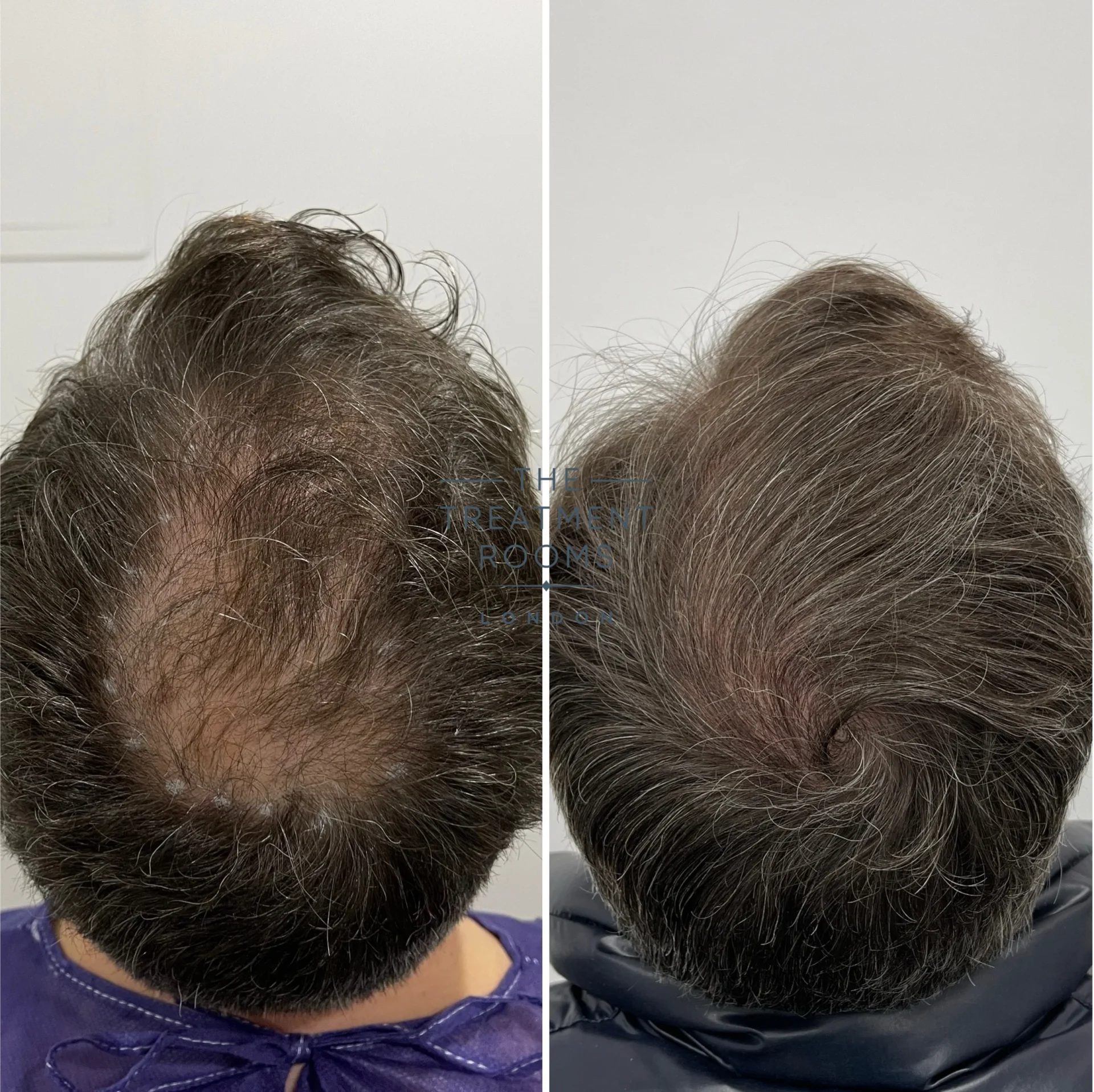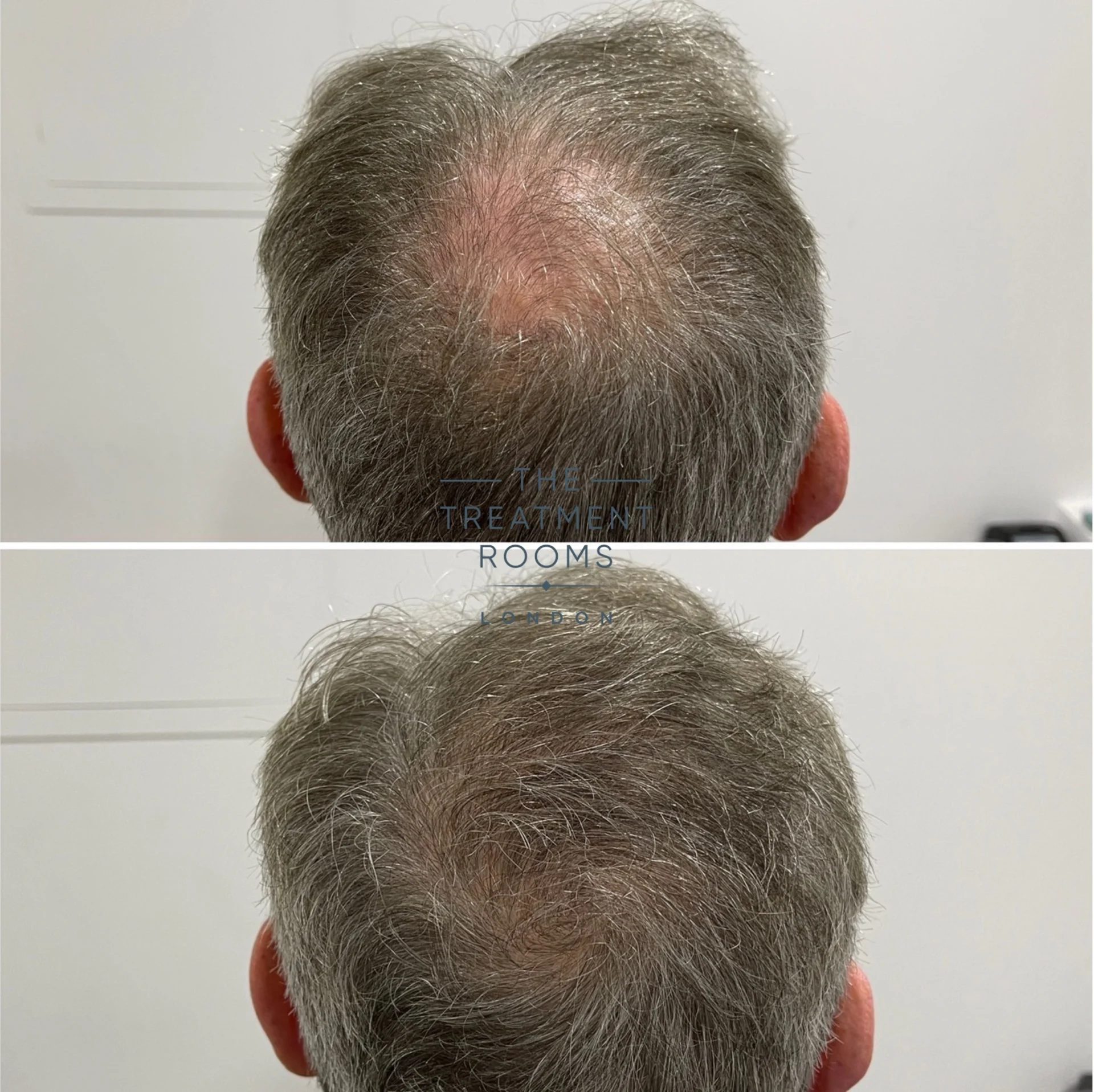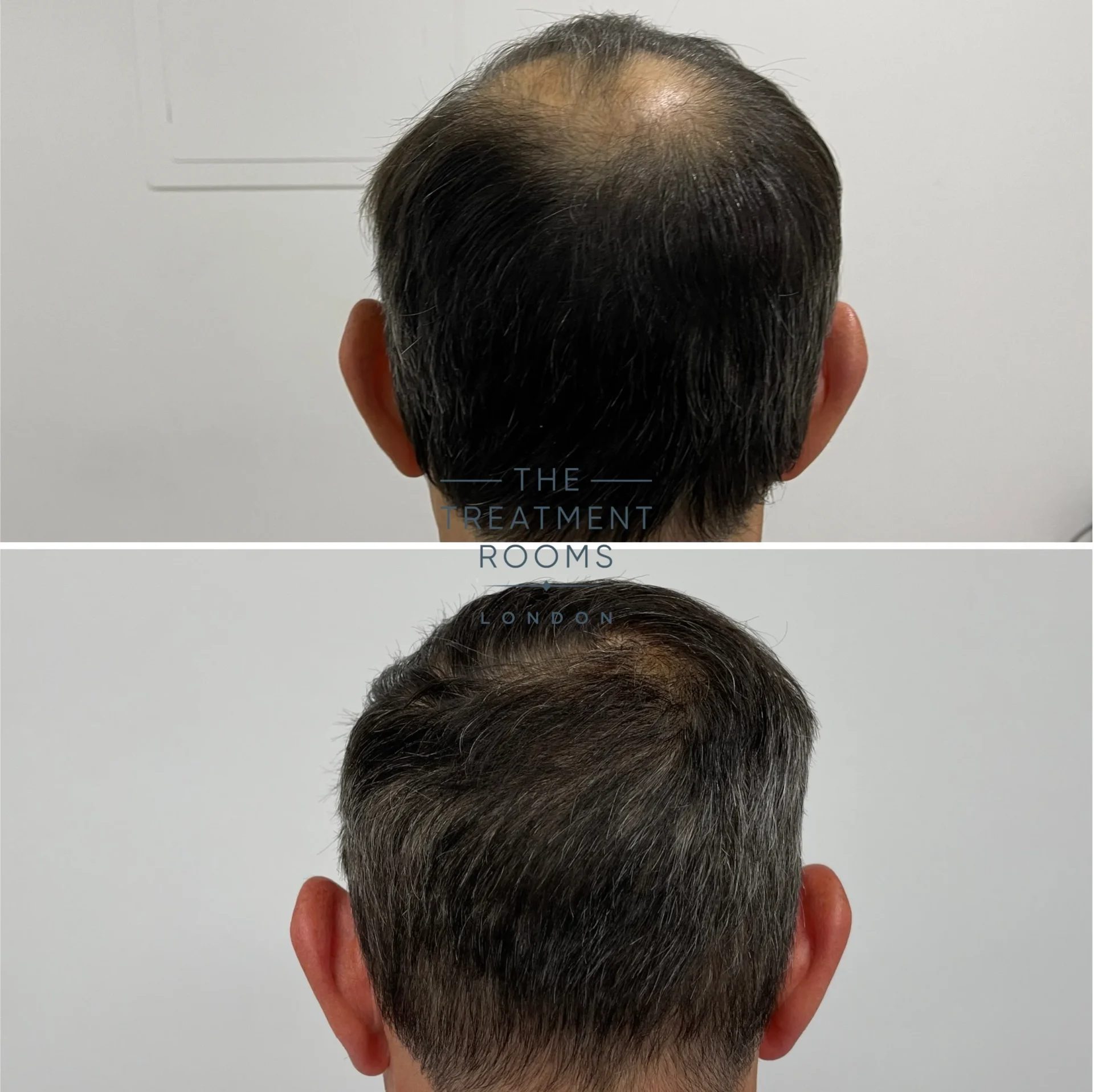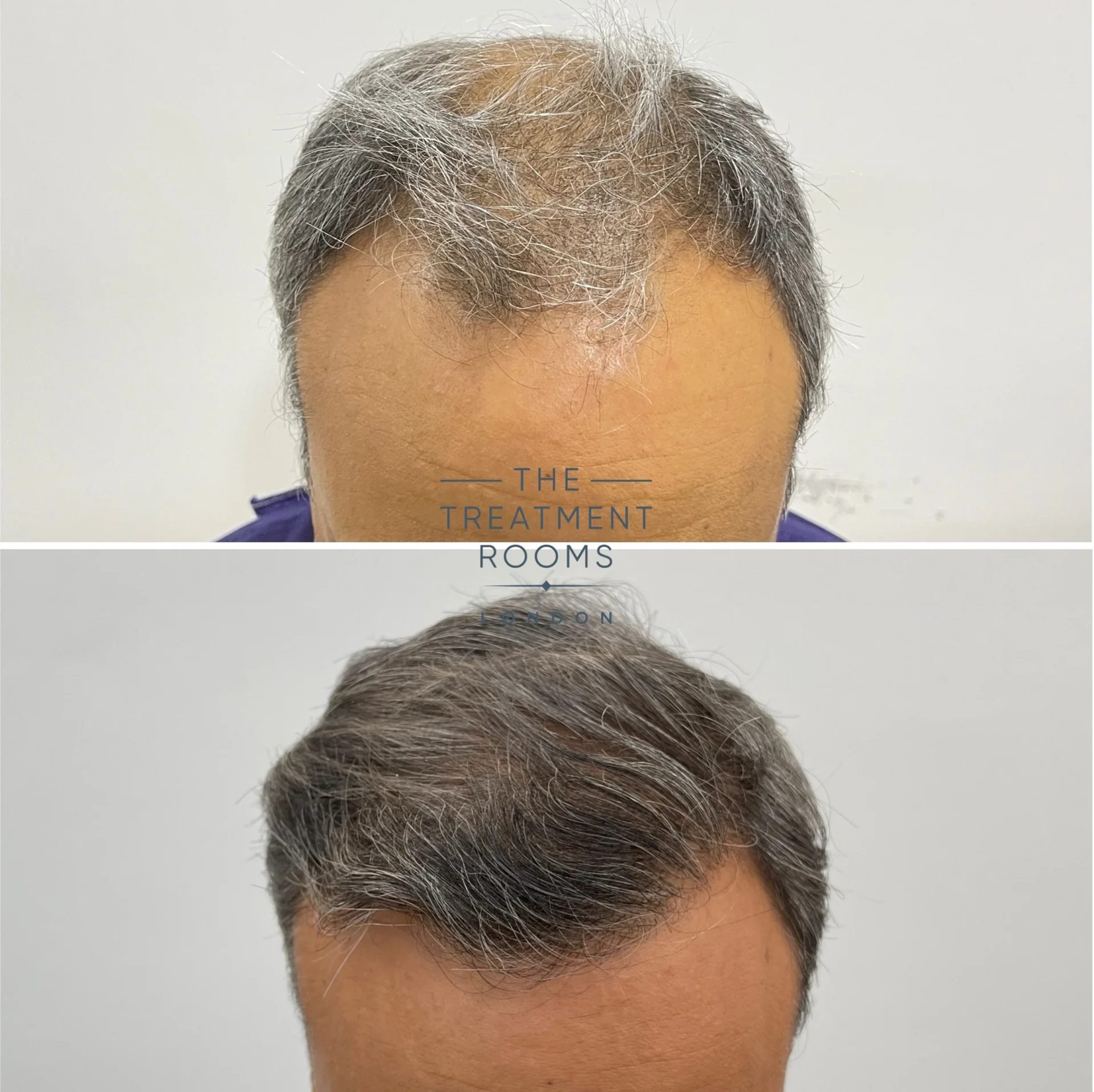Crown Hair Transplant Surgery
Crown Hair Transplant Surgery
Crown hair transplant surgery involves relocating hair from the back and sides of the scalp into the circular crown area. A crown hair transplant can be performed with an FUE or an FUT hair transplant. The procedure can be performed using the unshaven hair transplant or fully shaven technique. Balding at the ‘hair crown' or top of your head is a common experience that a lot of people go through at some point in their lives, especially those with a family history of hair loss.
There are also many non-surgical hair loss treatments available that can help preserve hair in your scalp and crown and prevent its loss. This is important to consider alongside having a crown hair transplant, as preventing ongoing hair loss will help preserve the crown hair transplant result.
In this guide, we'll be talking about everything from what the crown is through to causes of hair loss in this area and the treatments available.
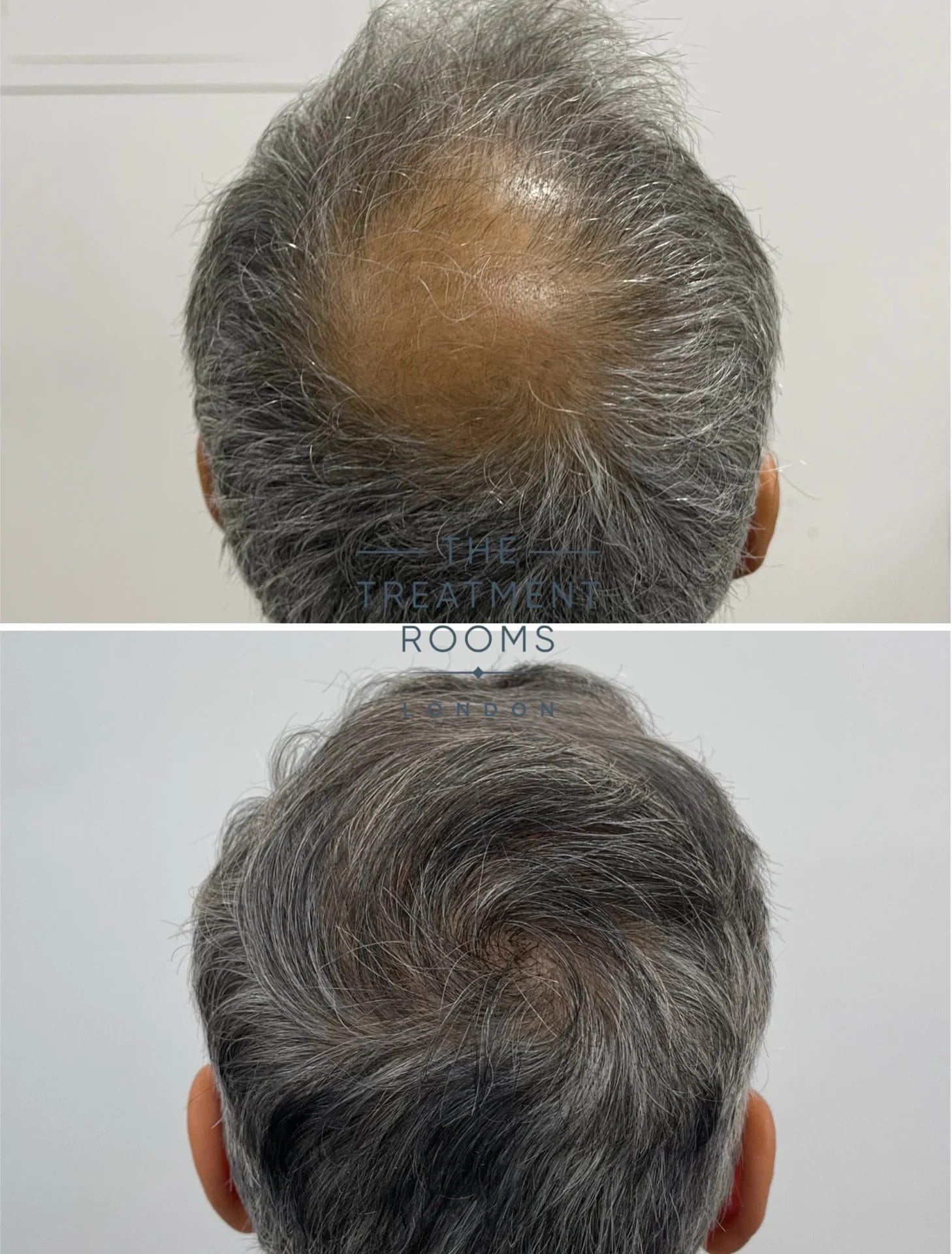
Why Does Hair Loss Happen On The Crown?
Hair loss on the crown, also known as the vertex, is a common phenomenon that affects many people, particularly men and transgender patients. The crown is the highest point of the scalp, located at the back of the head, and is prone to hair loss due to male pattern baldness. Male pattern baldness, also known as androgenic alopecia, is a condition where the hair follicles on the scalp are sensitive to dihydrotestosterone (DHT), a hormone that causes hair loss. As a result, the hair on the crown area begins to thin and eventually falls out, leading to a bald circular area.
Crown hair loss can also affect women who are suffering from severe female pattern baldness.
What is the crown hair?
The crown or ‘vertex' of your hair is the circular area located on the highest point on top of your head. The hair that grows from this point, congregated around your scalp in a circular pattern or formation, is called a “hair whorl”. You may even have two hair whorls in your crown which is also known as a ‘double crown'. This is also normal.
Who Is a Good Candidate for a Crown Hair Transplant?
Patients who are showing significant concern and distress around seeing the circular patch of hair loss in the crown may benefit from exploring a crown hair transplant. The balding patch in the crown may be more evident when getting a haircut or seeing the back of the head in the mirror. Some patients choose to sit in specific areas at work to ensure no-one can see their crown or they wear a hat to conceal the area. In these instances, patients are demonstrating significant avoidance behaviours because of their crown hair loss and may well benefit from speaking to a hair transplant surgeon to see how they can help.
A good candidate for crown hair transplant surgery tends to be a patient who has reached an age whereby they are unlikely to lose more hair or have stabilised their hair loss with medications like Finasteride and/or Minoxidil.
Patients who consider surgery too early may end up with further thinning the crown requiring more surgery. This requires careful planning and not all patients can have repeated surgery to restore hair that is continuing to fall out.
Crown Hair Transplant Procedure
A crown hair transplant procedure involves transplanting healthy hair follicles from the donor area, typically located at the back and sides of the head, to the balding area on the crown.
The procedure is usually performed using the FUE (Follicular Unit Extraction) or FUT (Follicular Unit Transplant) methods, which involves extracting hair follicles from the donor area and implanting them into the recipient area. The common process of crown hair transplant surgery involves:
- Outlining the crown area to be transplanted
- Numbing the donor area and crown recipient area with local anaesthesia
- Extraction of hair follicles to be transplanted
- Incisions made in the crown for new hairs to be implanted
- Lunch
- Implantation of new hairs in the crown to match the natural flow and spiral of the area
- Recovery at home
- 9-18 months for crown hair to grow
The entire procedure can take several hours, depending on the number of hair grafts needed. A crown hair transplant should give a result that lasts 10- 20 years or longer.

How Long Does Crown Hair Transplant Recovery Take?
The recovery following a crown hair transplant takes 5-10 days with most patients back to work around 10-11 days after their surgery. In the first few days following the procedure patients will need to take care of their implanted hair. Most patients are able to return to work and social life once the scabs have washed away and the hairs have embedded into the crown area by day 10.

When Will You See Results from a Crown Hair Transplant?
Patients will tend to see their final crown hair transplant results around 12 months following their procedure. Sometimes patients can grow earlier by 9 months and uncommonly some patients take longer to grow, taking up to 18 months.
Crown Hair Transplant Before and After
We have one of the biggest hair transplant before and after galleries in the world. You can see more of our cases and crown hair transplant results here: hair transplant before and after.
The Treatment Rooms London Reviews
BR's Crown transplant journey
Type of Surgery : FUE hair transplant
Hair Loss Level : Crown
Number of Grafts : 1877
"I have just returned from a 12 months follow-up consultation with Dr Vara and am extremely pleased with the outcome of the crown FUE hair transplant surgery. The entire process (the initial consultation, the day of surgery, and post-operative follow-ups) have been extremely professional. I felt looked after, all the steps were clearly explained in advance and any question I had was answered. So, I would highly recommend Dr Vara and this clinic for such a procedure."
Is crown hair loss different?
Losing hair on your crown can appear different from balding on the front. The underlying process that drives crown and frontal hair balding is the same. However, there are subtle differences that mean they look very different.
Because you look at your/someone else's crown from a steep angle, you look down onto the hair vertically. This means you can see more scalp, especially if you have dark hair and light skin. Have a look at the example below:

You can see that there were some hairs in this gentleman’s crown but as they have thinned, more scalp is now visible. This has consequences for crown hair loss treatment. The patient above underwent surgery to his crown to create better coverage in the area. His result is shown in the bottom half of the picture.
Treating and preventing crown hair loss
Crown hair transplants are not always the first treatment option. We understand that they can be expensive and If you’re just starting to lose your hair, other non-surgical hair loss treatments may be more beneficial.
By using non-surgical hair loss treatments like Finasteride and Minoxidil, you can prevent further hair loss and increase the density of each hair helping to hide any visible scalp. Together with undergoing surgery, this will help to restore hair in your crown and prevent future hair loss in the area.
Have a look at the case below. You will notice the patient is experiencing thinning and balding of his crown. By taking treatment to promote hair growth and thicken hair he has treated his hair loss and hidden more scalp in his crown. This has reversed his Norwood 3 Vertex/ Norwood 4V, to a Norwood 2V/ Norwood 3.

FUE vs FUT For Crown Hair Transplant Surgery
The main 2 techniques of hair transplant surgery are FUE and FUT. Choosing the right hair transplant technique requires a balanced discussion with your hair transplant Surgeon. For small to medium sized crowns, FUE hair transplant surgery may be the best option for patients. For large crowns or for patients who don't want too much hair to be shaved, an FUT hair transplant for the crown may be the preferred procedural choice. However, FUT hair transplant surgery tends to have a longer recovery time than FUE hair transplant surgery.
Crown FUE Hair Transplant Surgery
FUE (Follicular Unit Extraction) is a popular method for hair transplants, including crown hair transplants. The benefits of FUE include:
- Minimally invasive procedure: FUE is a comfortable procedure that requires no stitches.
- No linear scar: Unlike the FUT hair transplant method, FUE does not leave a linear scar on the back of the head.
- Quick recovery time: FUE allows for a quick recovery time, with most patients able to return to their normal activities within a 5-7 days.
- Natural-looking results: FUE produces natural-looking results, with the transplanted hair growing in a natural direction and pattern.

FUT Crown Hair Transplants
FUT (Follicular Unit Transplant) is also a good method for large crown hair transplants. The benefits of FUT include:
- The ability to transplant a large area of crown hair loss.
- Cheaper price compared to 2 sessions of FUE hair transplant surgery- sometimes patients who have large crowns require 2 sessions of surgery to cover the crown. This can sometimes be performed with a single day of FUT hair transplant surgery
- Natural-looking results: FUT produces natural-looking results, with the transplanted hair growing in a natural direction and pattern.
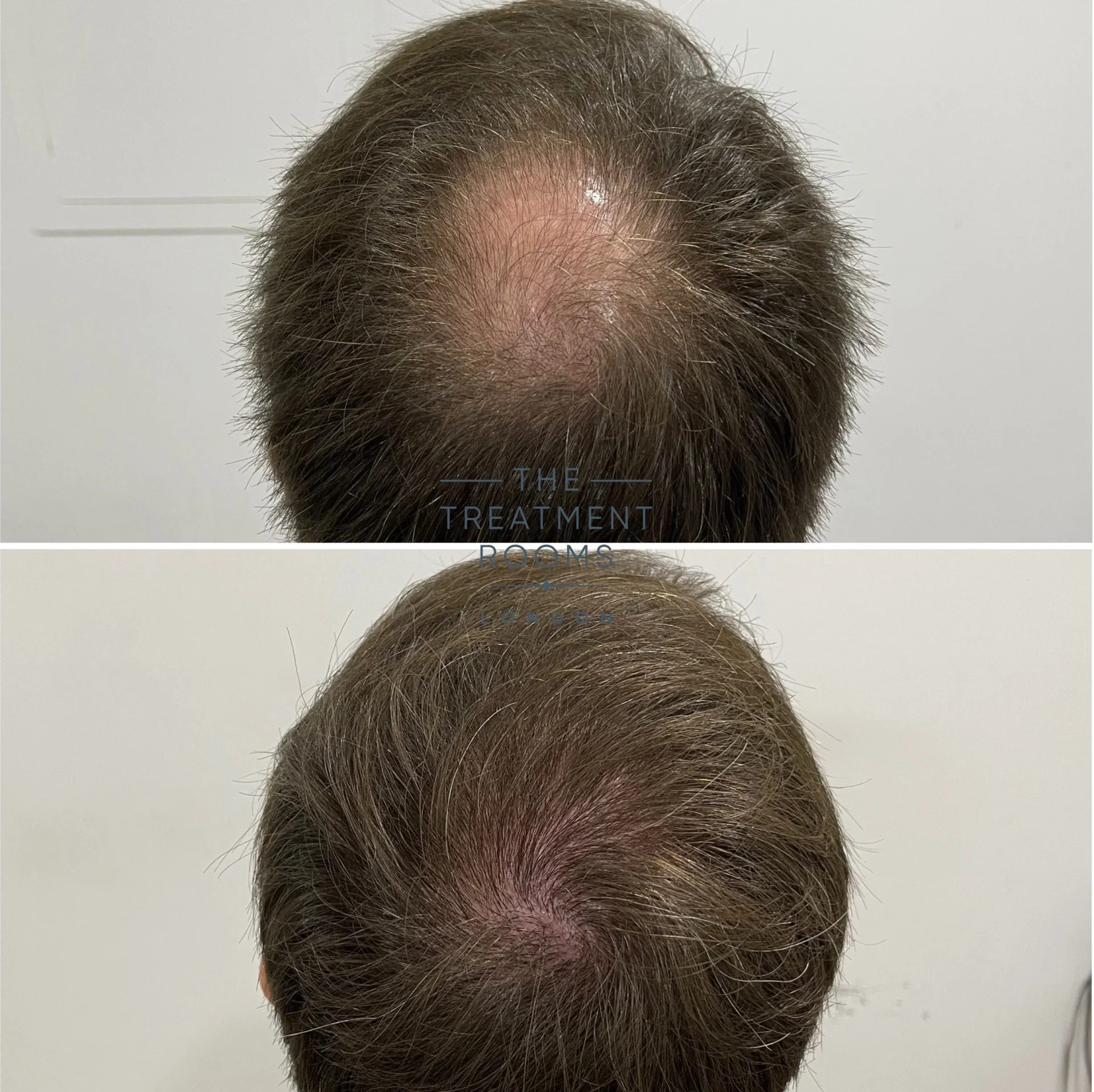
AK's Crown transplant journey
Type of Surgery : FUE hair transplant
Hair Loss Level : Norwood 4
Number of Grafts : 2343
"Really Professional Service. Procedure fully discussed. No pressures. On day of procedure treated well including lovely lunch. Music and Netflix and a team of 6 including both Consultants. Yes one can go abroad but I doubt you will get the services of two experienced Consultants and really good after care as required and reassurance of being in excellent hands if anything is awry"
Crown hair transplant surgery at The Treatment Rooms London
Unlike hair transplants at the front of the head, crown hair transplants generally require a lot more hair. This is because of the angle with which you look at the crown.
Take the crown hair transplant before and after above as an example. We are looking directly down onto the gentleman’s crown. Each hair is pointed directly at us and therefore less of the hair shaft is covering the surface of the scalp from our viewpoint. This means more scalp is visible.
For this reason, when we perform hair transplants on the crown, we require a larger volume of hair. Choosing a reputable hair transplant clinic is crucial for ensuring quality results and personalised care during your crown hair transplant surgery.
Because crown hair transplants require a greater volume of hair, your surgeon needs to carefully plan your operation. With a higher number of grafts needed, you and your surgeon will need to take into account the following points:
- How much hair do you have on the back and the sides of your head?
- Are your hairs thick or thin?
- The approximate number of grafts required to give you the desired coverage
- If you need a high number of grafts (e.g. >2000 follicles) then how will your surgeon plan the operation to make sure they all survive?
- If it is a lengthy procedure should you and your surgeon consider splitting the operation over 2 sessions
Crown hair transplant cost
The cost of a crown hair transplant depends on the size of your crown. It can range from £4000 to £10,000 and you may require 2 sessions of surgery in the crown to grow adequate coverage.
The cost will also be determined by the number of grafts you require for surgery, your hair type and whether you want to opt for a minimally shaven or unshaven crown hair transplant. You can calculate the approximate number of grafts you require for your surgery using our hair transplant graft calculator.
The Treatment Rooms London also offers 0% finance options for patients looking to spread the payment of their crown transplant over a year. Please mention your interest in our payment plans when you send your enquiry.
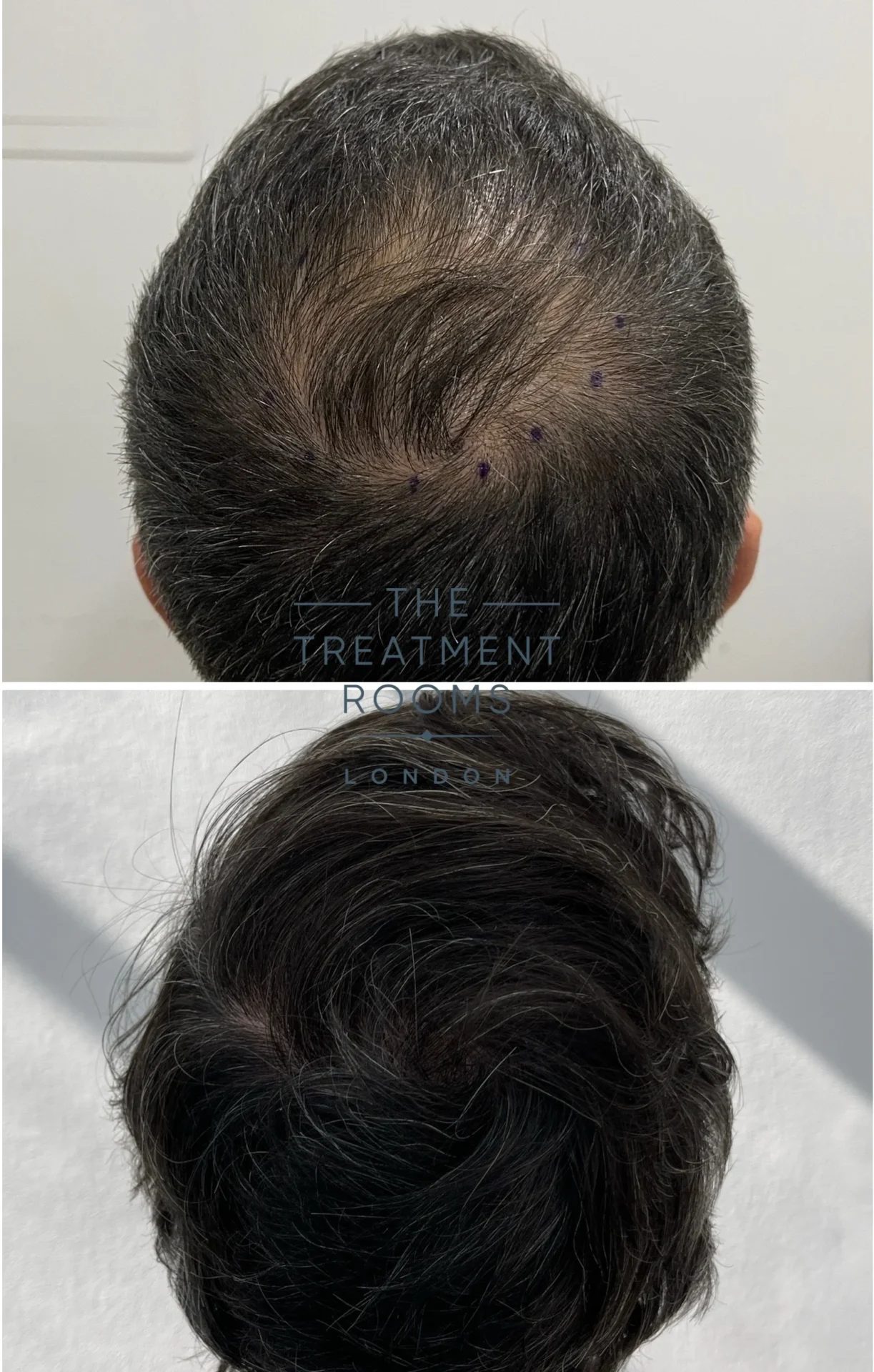
2239 grafts were implanted into this gentleman's crown and hairline he is 1 year post surgery in the above photo
Crown hair transplant aftercare
Crown hair transplants can be tricky to take care of once you have finished your operation. Because new grafts have been put into your crown, sleeping at night can be problematic. You might need to sleep at an angle to make sure you protect your grafts in the first 5-10 days.
As the grafts are at the back of your head where you cannot see them, you will need to be careful not to hit your head. This is particularly problematic on the day of the operation. As you have had your head numbed, your ability to know where the top of your head is in relation to ceilings, roofs, and doors can be impaired, so we make an effort to make sure you are safe when you enter a car or taxi after surgery.
Going through this hair transplant aftercare journey with your hair transplant clinic is important. They need to make you aware of all the risks that you might encounter in the days following your operation.
Choosing a Surgeon for your Crown hair transplant
We encourage you to make sure your hair transplant surgeon is fully registered and licensed, including the clinic they work at. In the UK this includes both:
- A GMC registration for the Surgeon
- A CQC license for the clinic (take a look at our CQC license)
Our renowned hair transplant Surgeons are:
- Dr Roshan Vara, Co-Owner and Hair Transplant Surgeon
- Dr Dilan Fernando, Co-Owner and Hair Transplant Surgeon
- Dr Puroshini Pather, Hair Transplant Surgeon
At The Treatment Rooms London, we welcome new patients exploring treatment options for their hair loss before deciding upon a hair transplant. As discussed above, this doesn’t have to be your first port of call.
For more information as to how The Treatment Rooms London will be able to help you with any non-surgical hair loss treatments or, to find out more about our hair transplant processes, get in touch. Our renowned surgeons will book in a consultation whereby all treatment options will be explored culminating in a tailored patient journey specific to your needs.
Crown Hair Transplant FAQs
A crown hair transplant is a procedure that restores hair in the crown section of the scalp. This area is prone to bald spots primarily due to male pattern baldness. The procedure involves transplanting hair follicles from the donor area to the area with balding or thinning.
Authored by
Reviewed by
Latest News
Female Pattern Baldness (Androgenetic Alopecia): Symptoms, Causes & Treatments
July 11, 2025
Female pattern baldness, also known as androgenetic alopecia, is a common genetic condition characterised by hair thinning…
What is DHT & Its Role in Hair Loss?
July 11, 2025
Hair loss is a common concern that millions, if not billions, of people experience at some point…
Complete Guide on Folic Acid and Hair Loss
July 9, 2025
Quick Summary Hair loss is a widespread concern that affects millions of people globally. While genetics, hormonal…


